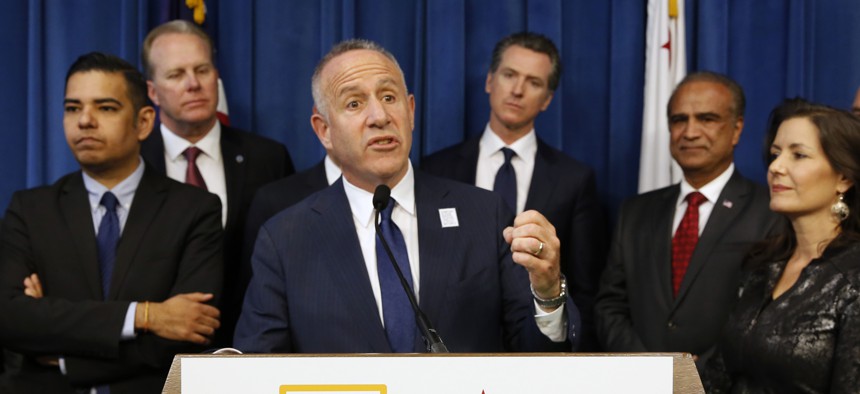California Plan to Reduce Homelessness Forces Cities, Counties to Step Up

In this March 20, 2019 file photo, Sacramento Mayor Darrell Steinberg, center, head of the BIG City Mayors, discusses the homeless problem after the group met with Gov. Gavin Newsom, fourth from right, in Sacramento, Calif. AP Photo/Rich Pedroncelli
A proposal by the governor’s Council of Regional Homeless Advisors would mandate that cities, counties and the state reduce homelessness or be vulnerable to court action.
Sacramento County is home to an estimated 5,570 homeless people, but has the shelter capacity to house only about 25% of that population.
It’s a problem Sacramento Mayor Darrell Steinberg acknowledges and says he knows needs to be addressed. He argues part of the solution is a plan to establish aggressive housing goals across California and require cities, counties and the state to meet them or be subject to legal action.
As the chairman of California Governor Gavin Newsom’s Council of Regional Homeless Advisors, Steinberg rolled out the plan earlier this month. To establish an enforceable mandate, the task force recommended the state legislature place a constitutional amendment on the 2020 ballot that would require both state and local governments to reduce the number of people living on the streets or in cars.
“Alleviating this crisis and helping the thousands of people who are on the streets can no longer be optional. It has to be required,” said Steinberg, discussing the proposal this week with Route Fifty.
California has the largest homeless population in the United States, estimated at 151,000 people, with about three-quarters of those people sleeping on the streets or in cars rather than in shelter facilities. As California has struggled to address its growing homelessness problem, President Donald Trump, a Republican, has blamed state and local leaders—often Democrats—for the crisis and threatened intervention by the federal government.
Sacramento is working to boost its shelter capacity by around 700 beds with a plan to construct Renewal Village, a site that could house people in tents, cabins or single-family homes and offering intensive services like a health clinic and job training. Steinberg said the hope for the project is that people could transition into permanent housing within about six months and the city could reduce its homeless population dramatically within a few years.
The task force proposal would require other cities to set similar goals. The mandate would require the state to set benchmarks to reduce homelessness and then allow cities and counties to draft plans to meet their own “aggressive but reasonable” goals.
“These plans would include specific benchmarks and timelines that jurisdictions would have to meet for moving people into permanent housing through both services offered in interim interventions and creation of housing opportunities,” the task force wrote in a Jan. 13 letter to the governor.
If municipalities are not meeting their targets, a designated public official such as the state’s attorney general would be able to file suit to compel them to take appropriate action. The goal of any legal action would be for courts to compel municipalities or the state to remove barriers tying up funds or slowing housing or shelter development, Steinberg said.
“No fines, no penalties, but remedial action,” he said.
Getting a constitutional amendment on the ballot will be an uphill battle, Steinberg said, requiring two-thirds support from the legislature this year.
Associations representing cities and counties in the state have expressed support for the plan’s intentions. But some appeared skeptical of the division of responsibilities and the additional resources needed to make it a reality.
“We support the strong steps of the governor and his advisory council are taking, but we must build upon current investments and support services that counties already provide,” said Graham Knaus, the executive director of the California State Association of Counties. “This crisis demands bold action and success requires clarity of responsibility and how shelter, housing, and needed services will be sited and funded.”
The League of California Cities emphasized that cities, counties and the state will need to collaborate on a solution as “no single local government agency has the resources to solve the crisis on its own.”
“Any workable solutions will require additional resources, including from the state and federal governments, and flexibility to address homelessness in a way that considers the diverse nature of all of our communities,” the league said in a statement
Steinberg admits California will likely need to provide additional resources to fund the type of housing and services needed, but first he believes a full assessment of state and local resources is needed to determine where service gaps currently exist. The heart of the state’s problem in addressing homelessness is not money, rather the fragmentation of responsibility, he said.
Newsom, in his budget proposal that the legislature will take up this year, has called for the state to spend an additional $1.4 billion to help with state and local homelessness efforts.
Encouraging municipalities to work together to achieve regional homelessness reduction goals might help smaller cities pool their resources while ensuring that one city doesn’t meet its benchmarks by simply relocating its homeless population outside its boundaries, Steinberg said. By holding all jurisdictions accountable for reducing homelessness within their borders, Steinberg said he hopes the mandate will inspire more regional cooperation on the issue.
Andrea Noble is a staff correspondent with Route Fifty.
NEXT STORY: 'The Mayor Can Set The Tone': How City Leaders Respond to Mass Shootings





